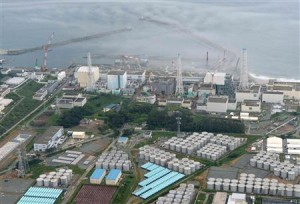Toxic Overflow of Thousands of Fukushima Tanks Following Heavy Rains
ENERGY, 28 Oct 2013
Lauren McCauley – Common Dreams
Environment Ministry Announces Clean-Up Delayed Until 2017

An aerial photograph of the Fukushima Daiichi nuclear power plant taken on Sunday, October 20, 2013 after heavy rainfall caused radioactive water to overflow storage tanks (bottom). (Photo: File/ Reuters)
Highly radioactive water crested the walls of some 1,000 storage tanks at Japan’s Fukushima Daiichi nuclear power facility after plant officials underestimated the amount of rainfall Sunday [20 Oct 2013].
According to officials with Tokyo Electric Power Co, or Tepco, water with high levels of radioactive strontium used to cool the damaged reactors overflowed thousands of containment tanks at the plant.
Reuters reports:
[C]ontainment areas surrounding 12 of 23 groups of tanks overflowed, with one of them containing Strontium-90 as highly concentrated as 710 Becquerels per liter – 71 times higher than the level set by the company as safe for release.
Strontium-90 is a by-product of the fission of uranium and plutonium in nuclear reactors as well as nuclear weapons, the U.S. Environmental Protection Agency says on its website.
Having planned for 30 to 40 millimeters of rainfall, the utility was “overwhelmed” when over 100 millimeters had accumulated by late afternoon.
“Our pumps could not keep up with the rainwater,” said Tepco spokesman Yoshikazu Nagai.
Tepco told Kyodo News that they “cannot rule out the possibility that contaminated water has reached the Pacific Ocean via drainage conduits near the clusters,” and added that they are working to determine that amount of contaminated water and what possible radioactive substances were released.
This latest contamination comes as Japan’s environment ministry announced Monday that efforts to clean up the six towns and villages surrounding the Fukushima plant are proving to be “much more complicated than originally thought” and will be delayed until 2017.”Ministry officials cited several reasons for the delay,” BBC reports, “including a lack of space for the waste from the decontamination work.”
This work is licensed under a Creative Commons Attribution-Share Alike 3.0 License
Go to Original – commondreams.org
DISCLAIMER: The statements, views and opinions expressed in pieces republished here are solely those of the authors and do not necessarily represent those of TMS. In accordance with title 17 U.S.C. section 107, this material is distributed without profit to those who have expressed a prior interest in receiving the included information for research and educational purposes. TMS has no affiliation whatsoever with the originator of this article nor is TMS endorsed or sponsored by the originator. “GO TO ORIGINAL” links are provided as a convenience to our readers and allow for verification of authenticity. However, as originating pages are often updated by their originating host sites, the versions posted may not match the versions our readers view when clicking the “GO TO ORIGINAL” links. This site contains copyrighted material the use of which has not always been specifically authorized by the copyright owner. We are making such material available in our efforts to advance understanding of environmental, political, human rights, economic, democracy, scientific, and social justice issues, etc. We believe this constitutes a ‘fair use’ of any such copyrighted material as provided for in section 107 of the US Copyright Law. In accordance with Title 17 U.S.C. Section 107, the material on this site is distributed without profit to those who have expressed a prior interest in receiving the included information for research and educational purposes. For more information go to: http://www.law.cornell.edu/uscode/17/107.shtml. If you wish to use copyrighted material from this site for purposes of your own that go beyond ‘fair use’, you must obtain permission from the copyright owner.